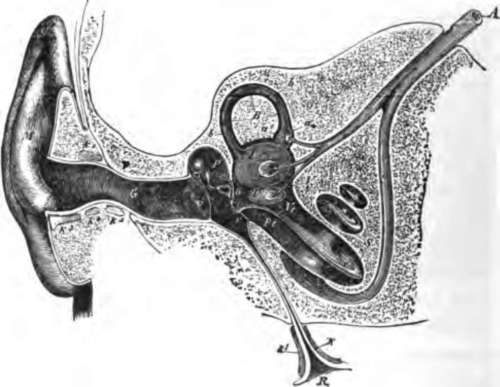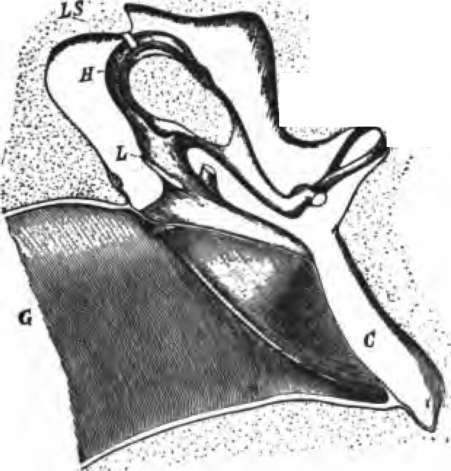Hearing
Description
This section is from the book "The Human Body: An Elementary Text-Book Of Anatomy, Physiology, And Hygiene", by H. Newell Martin. Also available from Amazon: The Human Body.
Hearing
The auditory organ (Fig. 95) consists of three portions, known respectively as the external ear, the middle ear or tympanum, and the internal ear or labyrinth; of these the latter is the essential one, containing the ends of the auditory nerve-fibres.
What is apt to result from short sight? Of what does the auditory organ consist?

Fig. 95. Semi-diagrammatic section through the right ear. If, concha. G, external auditory meatus. T. tympanic or drum membrane. P, Tympanum, o, oval foramen, r. round foramen. Extending from T to o is seen the chain of tympanic bones. R, Eustachian tube. V, B, S, bony labyrinth: V, vestibule; B, semicircular canal; S, cochlea. b, l, l', membranous semicircular canal and vestibule. A, auditory nerve dividing into branches for vestibule, semicircular canal, and cochea.
The External Ear
The External Ear consists of the expansion. M, seen on the exterior of the head, called the concha, and a passage leading in from it, the external auditory meatus, G. This passage is closed at its inner end by the tympanic or drum membrane, T. It is lined by a prolongation of the skin, through which numerous small glands, secreting the wax of the ear, open.
The Tympanum, Or Drum Chamber Of The Ear
The Tympanum, Or Drum Chamber Of The Ear (Fig. 96 and P, Fig. 95), is an irregular cavity in the temporal bone, closed externally by the drum membrane. From its inner side the Eustachian tube (R, Fig. 95) proceeds and opens into the pharynx. This tube allows air from the throat to enter the tympanum, and serves to keep equal the atmospheric pressure on each side of the drum membrane. Three small bones (Fig. 96) stretch across the tympanic cavity from the drum membrane to the labyrinth ; they transmit the vibrations of the membrane, produced by sound-waves in the air, to the liquid of the labyrinth. The outmost bone is the malleus; the inmost, the stapes; and the middle bone, the incus.
Describe the external ear.
What is the tympanum? The Eustachian tube? What is the use of the Eustachian tube? What bones lie in the tympanum? What is their function?

Fig. 96. The tympanic cavity and its bones, considerably magnified. G, the inner end of the external auditory meatus, closed internally by the conical tympanic membrane; L, the malleus, or hammer-bone; H, the incus, or anvil-bone; S, the stapes, or stirrup-bone.
Continue to:
